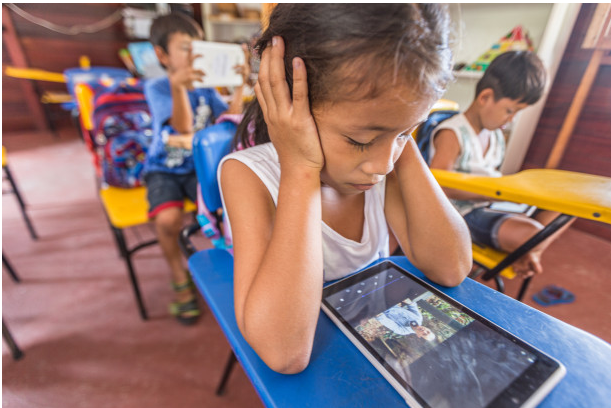联合国教科文组织最新发布的全球报告聚焦技术在教育中的应用,强调该领域管理和监督缺位的问题。教科文组织敦促各国为教育领域的技术设计及使用方式制定自己的规章制度,使其永远不会取代由教师引导的真人授课,并服务于实现全民优质教育这一共同目标。

Ismael Martínez Sánchez - ProFuturo
“数字革命具有不可估量的潜力,但正如其监管方式在社会上引起的担忧一样,我们需要对其在教育中的应用方式予以同样关注。技术必须用于提升学习体验,及学生与教师的福祉,而不是给他们带来危害。我们应始终把学生需求放在首位,支持教师工作。线上连接不能替代人际互动。”
——阿祖莱,联合国教科文组织总干事
2023年全球教育监测报告聚焦《技术运用于教育:谁来做主?》,将于今日在乌拉圭蒙得维的亚举行的活动中发布。该活动由教科文组织、乌拉圭教育与文化部和塞巴尔基金会(Ceibal Foundation)主办,有来自世界各地的18位教育部长出席。报告就技术在教育中的应用提出4个问题,供政府决策者和教育利益攸关方思考:
1. 是否恰当?
技术的应用可以在某些情况下改善学习效果。然而报告援引的证据显示,过度运用技术,或缺乏合格教师的监管,则技术并无裨益。例如,若仅向学生提供电脑,但教学过程没有教师参与,这并不能提高学习成效。在学校使用手机已被证明会分散学生注意力。尽管如此,只有不到四分之一的国家禁止学生在校使用手机。
“我们需要从技术用于教育的过往失误中吸取教训,以免重蹈覆辙。我们需要教会孩子们在有和没有技术辅助的情况下都能学习;从海量信息中筛选他们所需的,忽略无关的;让技术为人所用,但永远不至于取代教学过程中的师生互动。”
——安东尼尼斯
如果只开展远程教学,且线上授课内容并不总能符合当地情况,学生之间的学习不平等问题就会加剧。一项针对开放教育资源收集的研究发现,近90%的在线高等教育资源库的创建地为欧洲或北美;在开放教育资源共享全球图书馆中,92%的资料编写语言是英文。
2. 是否公平?
在COVID-19疫情期间,全球至少有5亿学生在仓促的线上授课转向中掉队,其中大多数是最贫困和居住在农村地区的学生。报告强调,受教育权越来越等同于有效的互联网接入,然而迄今四分之一的小学还没有电力供应。报告呼吁所有国家在2030年之前设定学校互联网连接基准,并将关注重点放在最边缘化的群体上。
3. 是否可推广?
我们急需可信、严谨、公正的证据,来证实技术给学习带来的附加值,但目前仍缺乏相关证明。多数证据来自美国,“有效信息交流中心”(What Works Clearinghouse)指出,在接受评估的教育干预措施中,只有不到2%的措施具有“较强或中等程度的有效性证据”。当证据仅来自技术公司自身时,就可能失之偏颇。
许多国家忽视了技术采购的长期成本。教育技术市场不断扩大,而基本教育需求仍未得到满足。在低收入国家推行基础数字化学习,以及使中低收入国家的所有学校接入互联网,这两项成本将使这些国家实现可持续发展目标4的现有资金缺口扩大50%。要实现教育的全面数字化转型,包括在学校和家庭提供互联网连接,每天仅运营成本就将超过10亿美元。
4. 是否可持续?
技术的快速变革给教育系统带来了适应压力。数字素养和批判思维变得日益重要,生成式人工智能的发展尤其助推这一趋势。报告所附的额外数据显示,这一适应过程已经启动:54%的受访国家已经确定了其未来想要培养的技能。但是在接受调查的51个国家中,只有11个开设了人工智能课程。
除了这些技能之外,基础读写能力也不容忽视,因为它对数字应用至关重要:阅读能力较强的学生被钓鱼邮件欺骗的可能性要小得多。
此外,教师也需要接受恰当的培训,但目前只有半数国家制定了培养教师信息化技能的标准。尽管5%的勒索软件攻击指向教育领域,但很少有教师培训计划涵盖网络安全。
可持续性还要求更好地保障技术使用者的权利。目前仅16%的国家立法保障教育领域的数据隐私。一项分析发现,163种教育技术产品中有89%可能对儿童进行调查。此外,在42个于疫情期间提供在线教育的国家里,有39个的做法“危及或侵犯”了儿童权利。
《全球教育监测报告》创建于2002年,由独立团队编写,并由教科文组织主办和发布。在2015年世界教育论坛上,160个政府授权此报告监测和报告可持续发展目标中的教育进展情况,特别是可持续发展目标4的监测框架以及国家和国际战略的实施情况,以协助确保所有相关合作伙伴履行承诺。
扩展阅读:
《技术运用于教育:谁来做主?》:
《全球教育监测报告》:
UNESCO issues urgent call for appropriate use of technology in education
A new global UNESCO report on technology in education highlights the lack of appropriate governance and regulation. Countries are urged to set their own terms for the way technology is designed and used in education so that it never replaces in-person, teacher-led instruction, and supports the shared objective of quality education for all.
The digital revolution holds immeasurable potential but, just as warnings have been voiced for how it should be regulated in society, similar attention must be paid to the way it is used in education. Its use must be for enhanced learning experiences and for the well-being of students and teachers, not to their detriment. Keep the needs of the learner first and support teachers. Online connections are no substitute for human interaction.
——Audrey Azoulay,
UNESCO Director-General
Entitled “Technology in education: A tool on whose terms?” , the 2023 Global Education Monitoring Report is being launched today at an event in Montevideo, Uruguay, hosted by UNESCO, the Ministry of Education and Culture of Uruguay and Ceibal Foundation with 15 ministers of education from around the world. It proposes four questions that policy makers and educational stakeholders should reflect upon as technology is being deployed in education:
1.Is it appropriate?
Using technology can improve some types of learning in some contexts. The report cites evidence showing that learning benefits disappear if technology is used in excess or in the absence of a qualified teacher. For example, distributing computers to students does not improve learning if teachers are not involved in the pedagogical experience. Smartphones in schools have also proven to be a distraction to learning, yet fewer than a quarter of countries ban their use in schools.
We need to learn about our past mistakes when using technology in education so that we do not repeat them in the future. We need to teach children to live both with and without technology; to take what they need from the abundance of information, but to ignore what is not necessary; to let technology support, but never supplant human interactions in teaching and learning.
——Manos Antoninis, Director
Learning inequities between students widen when instruction is exclusively remote and online content is not always context appropriate. A study of open educational resource collections found that nearly 90% of higher education online repositories were created either in Europe or in North America; 92% of the material in the Open Educational Resources Commons global library is in English.
1. Is it equitable?
During the COVID-19 pandemic, the rapid shift to online learning left out at least half a billion students worldwide, mostly affecting the poorest and those in rural areas. The report underlines that the right to education is increasingly synonymous with the right to meaningful connectivity, yet one in four primary schools do not have electricity. It calls for all countries to set benchmarks for connecting schools to the internet between now and 2030 and for the focus to remain on the most marginalized.
2. Is it scalable?
Sound, rigorous and impartial evidence of technology’s added value in learning is needed more than ever, but is lacking. Most evidence comes from the United States, where the What Works Clearinghouse pointed out that less than 2% of education interventions assessed had ‘strong or moderate evidence of effectiveness’. When the evidence only comes from the technology companies themselves, there is a risk it may be biased.
Many countries ignore the long-term costs of technology purchases and the EdTech market is expanding while basic education needs remain unmet. The cost of moving to basic digital learning in low-income countries and connecting all schools to the internet in lower-middle-income countries would add 50% to their current financing gap for achieving national SDG 4 targets. A full digital transformation of education with internet connectivity in schools and homes would cost over a billion per day just to operate.
3. Is it sustainable?
The fast pace of change in technology is putting strain on education systems to adapt. Digital literacy and critical thinking are increasingly important, particularly with the growth of generative AI. Additional data attached to the report show that this adaptation movement has begun: 54% of surveyed countries have defined the skills they want to develop for the future. But only 11 out of 51 governments surveyed have curricula for AI.
In addition to these skills, basic literacy should not be overlooked, as it is critical for digital application too: students with better reading skills are far less likely to be duped by phishing emails.
Moreover, teachers also need appropriate training yet only half of countries currently have standards for developing their ICT skills. Few teacher training programmes cover cybersecurity even though 5% of ransomware attacks target education.
Sustainability also requires better guaranteeing the rights of technology users. Today, only 16% of countries guarantee data privacy in education by law. One analysis found that 89% of 163 education technology products could survey children. Further, 39 of 42 governments providing online education during the pandemic fostered uses that ‘risked or infringed’ on children’s rights.
Notes to editors:
The Global Education Monitoring Report: Established in 2002, the GEM Report is an editorially independent report, hosted and published by UNESCO. At the 2015 World Education Forum, it received a mandate from 160 governments to monitor and report on progress on education in the Sustainable Development Goals (SDGs), with particular reference to the SDG 4 monitoring framework, and the implementation of national and international strategies to help hold all relevant partners to account for their commitments.
Read more:
Technology in education: A tool on whose terms?
The Global Education Monitoring Report:



